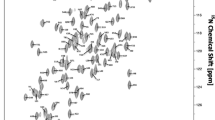Abstract
The Extracellular 1 (EC1) domain of E-cadherin has been shown to be important for cadherin–cadherin homophilic interactions. Cadherins are responsible for calcium-mediated cell–cell adhesion located at the adherens junction of the biological barriers (i.e., intestinal mucosa and the blood–brain barrier (BBB)). Cadherin peptides can modulate cadherin interactions to improve drug delivery through the BBB. However, the mechanism of modulating the E-cadherin interactions by cadherin peptides has not been fully elucidated. To provide a basis for subsequent examination of the structure and peptide-binding properties of the EC1 domain of human E-cadherin using solution NMR spectroscopy, the 1H, 13C and 15N backbone resonance of the uniformly labeled-EC1 were assigned and the secondary structure was determined based on the chemical shift values. These resonance assignments are essential for assessing protein–ligand interactions and are reported here.



Similar content being viewed by others
References
Bax A, Ikura M, Kay LE, Barbato G, Spera S (1991) Multidimensional triple resonance NMR spectroscopy of isotopically uniformly enriched proteins: a powerful new strategy for structure determination. Ciba Found Symp 161:108–119 discussion 119–135
Cepek KL, Shaw SK, Parker CM, Russell GJ, Morrow JS, Rimm DL, Brenner MB (1994) Adhesion between epithelial-cells and T-lymphocytes mediated by E-cadherin and the alpha(E)beta(7) Integrin. Nature 372(6502):190–193. doi:10.1038/372190a0
Delaglio F, Grzesiek S, Vuister GW, Zhu G, Pfeifer J, Bax A (1995) NMRPipe: a multidimensional spectral processing system based on UNIX pipes. J Biomol NMR 6(3):277–293
Grzesiek S, Bax A (1992) An efficient experiment for sequential backbone assignment of medium-Sized isotopically enriched proteins. J Magn Reson 99(1):201–207
Ikura M, Kay LE, Bax A (1990) A novel approach for sequential assignment of 1H, 13C, and 15 N spectra of proteins: heteronuclear triple-resonance three-dimensional NMR spectroscopy. Application to calmodulin. Biochemistry 29(19):4659–4667
Kiptoo P, Sinaga E, Calcagno AM, Zhao H, Kobayashi N, Tambunan US, Siahaan TJ (2011) Enhancement of drug absorption through the blood-brain barrier and inhibition of intercellular tight junction resealing by E-cadherin peptides. Mol Pharm 8(1):239–249. doi:10.1021/mp100293m
Makagiansar IT, Ikesue A, Nguyen PD, Urbauer JL, Urbauer RJ, Siahaan TJ (2002) Localized production of human E-cadherin-derived first repeat in Escherichia coli. Protein Expr Purif 26(3):449–454
Overduin M, Tong KI, Kay CM, Ikura M (1996) 1H, 15 N and 13C resonance assignments and monomeric structure of the amino-terminal extracellular domain of epithelial cadherin. J Biomol NMR 7(3):173–189
Shiraishi K, Tsuzaka K, Yoshimoto K, Kumazawa C, Nozaki K, Abe T, Tsubota K, Takeuchi T (2005) Critical role of the fifth domain of E-cadherin for heterophilic adhesion with alpha E beta 7, but not for homophilic adhesion. J Immunol 175(2):1014–1021
Trivedi M, Laurence JS, Williams TD, Middaugh CR, Siahaan TJ (2012) Improving the stability of the EC1 domain of E-cadherin by thiol alkylation of the cysteine residue. Int J Pharm 431(1–2):16–25. doi:10.1016/j.ijpharm.2012.03.051
Wishart DS, Sykes BD (1994) The 13C chemical-shift index: a simple method for the identification of protein secondary structure using 13C chemical-shift data. J Biomol NMR 4(2):171–180
Wishart DS, Sykes BD, Richards FM (1992) The chemical shift index: a fast and simple method for the assignment of protein secondary structure through NMR spectroscopy. Biochemistry 31(6):1647–1651
Wittekind M, Mueller L (1993) Hncacb, a high-sensitivity 3d NMR experiment to correlate amide-proton and nitrogen resonances with the alpha-carbon and beta-carbon resonances in proteins. J Magn Reson Ser B 101(2):201–205. doi:10.1006/jmrb.1993.1033
Zhang Y, Sivasankar S, Nelson WJ, Chu S (2009) Resolving cadherin interactions and binding cooperativity at the single-molecule level. Proc Natl Acad Sci USA 106(1):109–114. doi:10.1073/pnas.0811350106
Acknowledgments
This work is supported by a grant from NIH/NINDS (R01 NS075374-01). M.E.K. was supported by a PhRMA Foundation Postdoctoral Fellowship in Pharmaceutics. The authors would like to thank to the NMR Facility of the NIH COBRE Protein Structure and Function Grant (P20 RR017708).
Ethical Standard
The authors declare that the experiments comply with the current laws of the United States.
Conflict of interest
The authors declare that they have no conflict of interest.
Author information
Authors and Affiliations
Corresponding authors
Rights and permissions
About this article
Cite this article
Prasasty, V.D., Krause, M.E., Tambunan, U.S.F. et al. 1H, 13C and 15N backbone assignment of the EC-1 domain of human E-cadherin. Biomol NMR Assign 9, 31–35 (2015). https://doi.org/10.1007/s12104-013-9539-6
Received:
Accepted:
Published:
Issue Date:
DOI: https://doi.org/10.1007/s12104-013-9539-6




